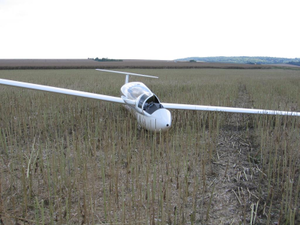Lift (soaring)
Since long time ago, when we were still hiding from dinosaurs mankind has been dreaming of the idea to Fly like a bird. Flying didn't seem to be that hard, but the really hard part was landing in such a manner that you walk away without becoming an instant burger for that dinosaur.
Quite soon the idea that you could skip the flying thing and immediately start landing came about. This was done successfully by the German Lilienthal and the Famous Wright Brothers. To survive the crash they used loads of wood and cotton because both materials are very good at absorbing energy and cushioning the blow, thus minimizing damage to the body of the pilot.
During World War II the RAF and US Air Force thought about transporting jeeps and supplies to Europe by means of gliders. This required improving the crash-ability of the gliders to prevent the jeeps from being fatally damaged and thus unable to fight against the Germans.
A brilliant engineer came to the idea to use people for that purpose, since a soldier's life is worth very little and human bodies are over 70% of water anyways. So because of their good bending and energy-absorbing qualities, and their relative cheap cost, soldiers were utilized for this purpose.
After World War II, due to retardataion of pilots, and an increase in average cargo weight, more padding was required. During the sixties, pilot skills decreased so much that sailplanes became too heavy to get of the ground. Some clever German thought about the idea of glass-fiber. Although, glass is worse than wood at absorbing energy, it is also much stronger which made the production of even bigger sailplanes possible.
The ever-decreasing pilot education lead to an impasse, but as sailplanes of the era had plenty of room to store hundreds of liters of water, most pilots were able to exit the airplanes alive.
Common misconceptions[edit | edit source]
Some glider pilots still believe that the sun counteracts gravity. They think that - by flying underneath clouds - they can beat gravity. Of course they're wrong and always have to crash somewhere whether they are flying underneath a cloud or not.
Another common misconception is the idea that local gravity is always perpendicular to the earth. Flying besides a mountain creates horizontal gravity and pilots believe in combination with the correct position of the sun you could climb. That's complete nonsense because many pilots crash into mountains but still a lot of sailplane pilots believe this crap.
Competitions[edit | edit source]
There is an age-old drive to compete and show your talent. Also in Sailplanes there are several ways to show your talent such as aerobatics which is the art of making the crash look as violent and dangerous as possible. Good acro-pilots use a co-pilot sitting in front of them to improve crashability. Cross-country racing is art to crash as far away as you can. 200 or 300 kilometres away from home crashing is not uncommon.
Learn to Soar[edit | edit source]
Fly with a certified instructor and learn this delicate art. Practice crashing over and over again until the instructor deems you safe and ready to crash by yourself. After a good amount of experience, you can go for your license. Crash three times with an FAA examiner and, maybe the bastard will sign you off.

